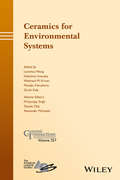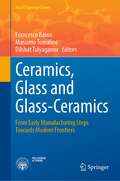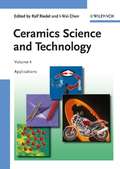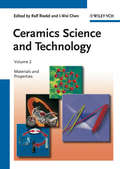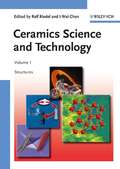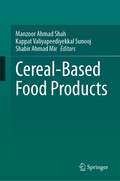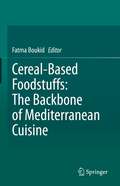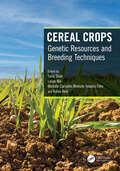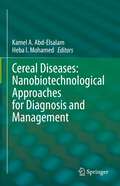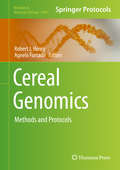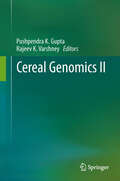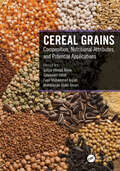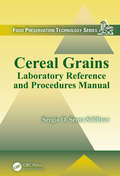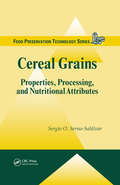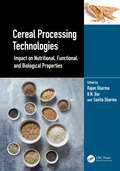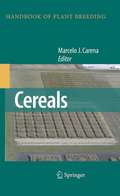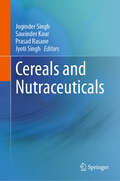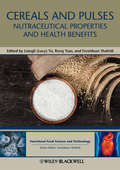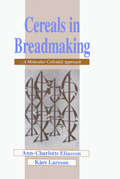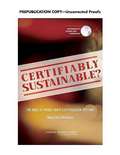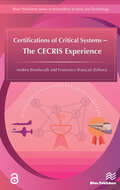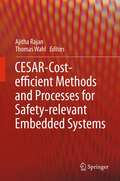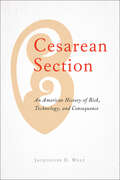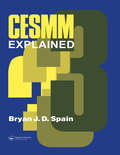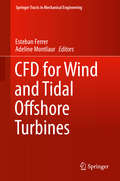- Table View
- List View
Ceramics for Environmental Systems (Ceramic Transactions #Vol. 257)
by Tatsuki Ohji Alexander Michaelis Girish M. Kale Lianzhou Wang Mrityunjay Singh Nobuhito Imanaka Waltraud M. Kriven Manabu FukushimaThis volume contains a collection of 14 papers submitted from the below five symposia held during the 11th International Symposium on Ceramic Materials and Components for Energy and Environmental Applications (CMCEE-11), June 14-19, 2015 in Vancouver, BC, Canada: Photocatalysts for Energy and Environmental Applications Advanced Functional Materials, Devices, and Systems for the Environment Geopolymers, Inorganic Polymer Ceramics and Sustainable Composites Macroporous Ceramics For Environmental and Energy Applications Advanced Sensors for Energy, Environment, and Health Applications
Ceramics, Glass and Glass-Ceramics: From Early Manufacturing Steps Towards Modern Frontiers (PoliTO Springer Series)
by Francesco Baino Massimo Tomalino Dilshat TulyaganovThis book presents a state-of-the-art overview of the major aspects involved in the science, technology and applications of ceramics, glasses and glass-ceramics. After providing an historical perspective of the development and use of ceramics and glasses along the Silk Road, the theoretical background and fabrication techniques of such materials are described and discussed. A special focus is dedicated to emerging high-tech applications in various fields, including medicine, energy, optics and photonics, sensors, sustainability and circular economy. The chapters are written by leading experts in their respective fields and highlight the contemporary challenges associated to each topic. This book will serve as a valuable reference for both early-stage and skilled researchers as well as industry professionals interested in the broad field of glasses and ceramics.
Ceramics Science and Technology, Applications
by Ralf Riedel I-Wei ChenAlthough ceramics have been known to mankind literally for millennia, research has never ceased. Apart from the classic uses as a bulk material in pottery, construction, and decoration, the latter half of the twentieth century saw an explosive growth of application fields, such as electrical and thermal insulators, wear-resistant bearings, surface coatings, lightweight armour, or aerospace materials. In addition to plain, hard solids, modern ceramics come in many new guises such as fabrics, ultrathin films, microstructures and hybrid composites.Built on the solid foundations laid down by the 20-volume series Materials Science and Technology, Ceramics Science and Technology picks out this exciting material class and illuminates it from all sides.Materials scientists, engineers, chemists, biochemists, physicists and medical researchers alike will find this work a treasure trove for a wide range of ceramics knowledge from theory and fundamentals to practical approaches and problem solutions.
Ceramics Science and Technology, Materials and Properties
by I-Wei Chen Ralf RiedelAlthough ceramics have been known to mankind literally for millennia, research has never ceased. Apart from the classic uses as a bulk material in pottery, construction, and decoration, the latter half of the twentieth century saw an explosive growth of application fields, such as electrical and thermal insulators, wear-resistant bearings, surface coatings, lightweight armour, or aerospace materials. In addition to plain, hard solids, modern ceramics come in many new guises such as fabrics, ultrathin films, microstructures and hybrid composites. Built on the solid foundations laid down by the 20-volume series Materials Science and Technology, Ceramics Science and Technology picks out this exciting material class and illuminates it from all sides. Materials scientists, engineers, chemists, biochemists, physicists and medical researchers alike will find this work a treasure trove for a wide range of ceramics knowledge from theory and fundamentals to practical approaches and problem solutions.
Ceramics Science and Technology, Volume 1: Structures (Ceramics Science and Technology (VCH) #1)
by Ralf Riedel I-Wei ChenAlthough ceramics have been known to mankind literally for millennia, research has never ceased. Apart from the classic uses as a bulk material in pottery, construction, and decoration, the latter half of the twentieth century saw an explosive growth of application fields, such as electrical and thermal insulators, wear-resistant bearings, surface coatings, lightweight armour, or aerospace materials. In addition to plain, hard solids, modern ceramics come in many new guises such as fabrics, ultrathin films, microstructures and hybrid composites. Built on the solid foundations laid down by the 20-volume series Materials Science and Technology, Ceramics Science and Technology picks out this exciting material class and illuminates it from all sides. Materials scientists, engineers, chemists, biochemists, physicists and medical researchers alike will find this work a treasure trove for a wide range of ceramics knowledge from theory and fundamentals to practical approaches and problem solutions.
Cereal-Based Food Products
by Manzoor Ahmad Shah Kappat Valiyapeediyekkal Sunooj Shabir Ahmad MirCereal grains and their products are staples in the diet of almost every culture of the world and have made an important contribution to daily nutrient requirements. Cereal grains are high in carbohydrates, good sources of protein and provide varying amounts of fibre, vitamins and minerals. The nutritional composition of grains may vary depending on the variety and environmental growing conditions. A number of cereal products are prepared from all the regions of the world. Cereals are processed into many products such as bread, cookies, cakes and pasta and are consumed daily by the majority of the population and play an important place in human nutrition. Cereal Based Food Products is the first book of its kind, focusing on the preparation methodology of cereal products. The chapters focus on different types of cereal products, processing technology, quality aspects and packaging requirements. All of the important cereal-based foods are covered in full, including sections on bread, cookies, cakes and muffins, pasta and noodles and many more including their packaging, preparation methods and ingredients. With this text researchers will find a comprehensive single source for information on the processing of cereal-based food products.Covers different types of products prepared from cereal grains;Focuses on production technology for the development of cereal products;Presents information on packaging requirements of cereal products.
Cereal-Based Foodstuffs: The Backbone of Mediterranean Cuisine
by Fatma BoukidCereal-Based Foodstuffs: The Backbone of the Mediterranean provides an overview of cereal-based products in the Mediterranean region, illustrating the spectrum of products from past to present and their various processing methods. The text explores new and understudied market trends in cereal-based products, such as cereal-pulse blends, pulse pastas, and flat breads. Chapters cover products originating in North Africa, such as bulgur and couscous, which are consumed worldwide but underrepresented in the scientific literature. Contributing authors also offer a legislative perspective on issues of food safety, the European Food Safety Association’s definition of “novel foods,” and the position of traditional foods in the Mediterranean food industry. This wide-ranging text thus serves members of both the scientific and industrial community seeking better coverage of global cereal product trends.
Cereal Crops: Genetic Resources and Breeding Techniques
by Tariq Shah, Lixiao Nie, Marcelo Carvalho Minhoto Texeira Filho, and Rabia AmirCereal Crops: Genetic Resources and Breeding Techniques provides the reader practical tools for understanding relationships and challenges of successful farming; improvements to genetic modifications; and environmentally sound methods of production of bulk and quality cereals including wheat, maize, rice, barley, and millets. It explores the trait mapping, cropping systems, genome engineering, and identification of specific germplasms needed for the more effective development of biotic and abiotic stress resistant cereals within the framework of ensuring future food supplies around the world. Features:Focuses on cropping systems, genetics and genome engineering for higher crop production at a global level.Features information on specific prebiotic formulas to ward off adverse effects of antibiotics.Covers mechanistic as well as practical approaches for enhancing crop production in a sustainable way.Includes further in-depth analysis of various topics following each chapter.This is a vital resource for researchers, crop biologists, and students working with crop production and climate changes that have a significant impact on crop production, spanning basic to advanced level discussions of plant breeding, molecular genetics, and agronomy. Covering mechanistic and practical approaches for enhancing crop production in a sustainable way, this text is beneficial to intensive farmers and stakeholders in the field of crop production.
Cereal Diseases: Nanobiotechnological Approaches for Diagnosis and Management
by Kamel A. Abd-Elsalam Heba I. MohamedNew ways to improve cereal crops against fungal, bacterial, and viral diseases are covered in this book that was put together by a group of experts. These include genetics, genome editing systems, and nano-biotechnological tools. Cereal crops are mainly the world's leading food crops and feed a large share of the world population. However, external factors, such as pathogens, have often threatened their productivity. Like wheat, rice, maize, oats, barley, millet and storage, etiology, epidemiology, and diseases in cereal crop management. In addition, the importance of crop genetics and genomics in combating pathogens has been discussed. This book offers up-to-date information on new methods, such as the potential of the genome editing system for crop improvement, in particular the CRISPR-Cas system. The current volume also talks about identification, plant breeding, genome editing, and nanotechnology tools that can be used to fight disease in cereal crops. This book is good for students, teachers, and researchers who study biotic stress in cereals, as well as scientists who study nanotechnology, disease resistance, pathogen biology, genome editing, agriculture sciences, and future biotechnology.
Cereal Genomics: Methods and Protocols (Methods in Molecular Biology #1099)
by Robert J. Henry Agnelo FurtadoIn "Cereal Genomics: Methods and Protocols," expert researchers provides modern protocols for the analysis and manipulation of cereal genomes. Techniques for isolation and analysis of DNA and RNA from both the vegetative tissues and from the more challenging seeds of cereals are described. Tools for the isolation, characterization and functional analysis of cereal genes and their transcripts are detailed. Methods for molecular screening of cereals and for their genetic transformation are also covered. Written in the highly successful "Methods in Molecular Biology "series format, chapters include introductions to their respective topics, lists of the necessary materials and reagents, step-by-step, readily reproducible laboratory protocols, and tips on troubleshooting and avoiding known pitfalls. Authoritative and practical, "Cereal Genomics: Methods and Protocols" provides a comprehensive resource for those studying cereal genomes. "
Cereal Genomics II
by Rajeev Varshney Pushpendra K. Gupta"Cereal Genomics" published in 2004 served the purpose of collecting all information on cereal genomics at one place and was well received by the cereal workers through-out the world. The last eight years have witnessed significant advancement in the field of cereal genomics. For instance, high-density genetic maps, physical maps, QTL maps and even draft genome sequence have become available for several cereal species. Furthermore, the next generation sequencing (NGS) technologies have revolutionized genomics research, so that it is possible now to sequence genomes of hundreds or thousands of accessions of an individual cereal crop. Significant amounts of data generated using these NGS technologies created a demand for computational tools to analyse this massive data. In view of these developments, the Editors realised that there was a need to have an updated volume on the present status and future prospects of cereal genomics. These developments related to technology and the tools have been documented in this volume, thus supplementing our earlier edited volume "Cereal Genomics". "Cereal Genomics II" discusses advances in cereal genomics research made during the last eight years, and presents state-of-art cereal genomics and its utilization involving both basic research such as comparative genomics and functional genomics, and applied research like QTL mapping and molecular breeding.
Cereal Grains: Composition, Nutritional Attributes, and Potential Applications
by Gulzar Ahmad Nayik Tabussam Tufail Faqir Muhammad Anjum Mohammad Javed AnsariEver since the beginnings of agriculture, cereals have provided unlimited health benefits to mankind as a staple food in our diet. Cereals are rich in complex carbohydrates that provide us ample energy, and help to prevent many diseases such as constipation, colon disorders, and high blood sugar levels. They enrich our overall health with abundant proteins, fats, lipids, minerals, vitamins, and enzymes. In every part of the world cereals are consumed for breakfast, lunch or dinner. Cereal Grains: Composition, Nutritional Attributes, and Potential Applications provides an overview of cereals including their properties, chemical composition, applications, postharvest losses, storage, and quality. Various well-versed researchers across the globe share their knowledge and experience covering cereal’s role in food security, allergens in grains, phytochemical profile, industrial applications, health benefits, global standard of cereals, and recent advances in cereal processing. Key Features: Contains comprehensive information on general composition and properties of cereals. Discusses the recent advances in cereal technology Provides knowledge on bioactive characterization of cereal grains Contain information on future aspect of grain quality and allergens in cereal grains This handbook is a valuable resource for students, researchers, and industrial practitioners who wish to enhance their knowledge and insights on cereal science. Researchers, scientists, and other professionals working in various cereal processing industries and other horticultural departments will also find the comprehensive information relevant to their work.
Cereal Grains: Laboratory Reference And Procedures Manual (Food Preservation Technology Ser.)
by Sergio O. Serna-SaldivarWhile cereals remain the world’s largest food yield – with more than 2.3 billion metric tons produced annually – consumer demands are on the rise for healthier cereal products with greater nutrition. Cereal Grains: Properties, Processing, and Nutritional Attributes provides a complete exploration of the scientific principles related to domestication, morphology, production, and storage of cereal grains. It also describes their physical and chemical characteristics and explains how these properties relate to industrial processing and nutritional value. This single-authored textbook lays the foundation for subsequent chapters by first addressing the importance of cereals for mankind, the comparative chemical and physical grain properties of the various types of cereal grains, the morphology and grain anatomy of caryopses, and the physiology of fertilization, grain development, and germination. The book then covers grain storage, pest control, industrial dry milling, wet milling, and both dry and fresh masa industries. A discussion of processing, quality control, and the role of cereals in human and animal nutrition rounds out the book’s complete coverage. Each chapter includes a set of up-to-date references along with selected questions to bolster comprehension of the discussed concepts. The book also contains a glossary of 600 scientific and technical terms to aid in the understanding of words used throughout the text. Cereal Grains: Properties, Processing, and Nutritional Attributes was designed especially for students and lecturers, but it is also helpful as a guide for scientists, food product developers, and nutritionists working to stay ahead of the curve.
Cereal Grains: Properties, Processing, and Nutritional Attributes (Food Preservation Technology Ser.)
by Sergio O. Serna-SaldivarWhile cereals remain the world's largest food yield - with more than 2.3 billion metric tons produced annually - consumer demands are on the rise for healthier cereal products with greater nutrition. Cereal Grains: Properties, Processing, and Nutritional Attributes provides a complete exploration of the scientific principles related to domesticatio
Cereal Processing Technologies: Impact on Nutritional, Functional, and Biological Properties
by Rajan Sharma B. N. Dar Savita SharmaCereals are the principal dietary components of human diet and have been for several thousand years. Whole grain cereals are not only an excellent source of energy, but also enrich the diet. The processing of cereals prior to consumption is a necessary step in production chain to make them palatable and enhance bio- and techno-functional performance. Cereal Processing Technologies: Impact on Nutritional, Functional, and Biological Properties reviews cereal processing technologies and their impact on quality attributes of cereals, detailing the processing techniques of cereals with recent advancements followed by their impact on nutritive, functional and biological potential. Each chapter covers three major components as a) technological details for the processing treatment, b) impact on nutritive, functional and biological properties and c) characterization of processed products. Key Features: Focuses on different cereals for nutritive and functional characteristics Explores mechanical, biological, thermal and non-thermal processing treatments of cereals Presents impact of different treatments on biological and techno-functional properties of cereals Discusses characteristics of the processed products The contents of Cereal Processing Technologies are an asset for researchers, students and professionals, and can be potentially used as a reference and important resource for academia and future investigations. This book helps readers identify how different techniques for processing cereal grains enhance the targeted nutritional and functional quality.
Cereals (Handbook of Plant Breeding #3)
by Marcelo J. CarenaAgriculture depends on improved cultivars, and cultivars are developed through proper plant breeding. Unfortunately, applied plant breeding programs that are focused on cereal commodity crops are under serious erosion because of lack of funding. This loss of public support affects breeding continuity, objectivity, and, perhaps equally important, the training of future plant breeders and the utilization and improvement of plant genetic resources currently available. Breeding programs should focus not only on short-term research goals but also on long-term genetic improvement of germplasm. The research products of breeding programs are important not only for food security but also for commodity-oriented public and private programs, especially in the fringes of crop production. Breeding strategies used for long-term selection are often neglected but the reality is that long-term research is needed for the success of short-term products. An excellent example is that genetically broad-based public germplasm has significantly been utilized and recycled by industry, producing billions of dollars for industry and farmers before intellectual property rights were available. Successful examples of breeding continuity have served the sustainable cereal crop production that we currently have. The fact that farmers rely on public and private breeding institutions for solving long-term challenges should influence policy makers to reverse this trend of reduced funding. Joint cooperation between industry and public institutions would be a good example to follow. The objective of this volume is to increase the utilization of useful genetic resources and increase awareness of the relative value and impact of plant breeding and biotechnology. That should lead to a more sustainable crop production and ultimately food security. Applied plant breeding will continue to be the foundation to which molecular markers are applied. Focusing useful molecular techniques on the right traits will build a strong linkage between genomics and plant breeding and lead to new and better cultivars. Therefore, more than ever there is a need for better communication and cooperation among scientists in the plant breeding and biotechnology areas. We have an opportunity to greatly enhance agricultural production by applying the results of this research to meet the growing demands for food security and environmental conservation. Ensuring strong applied plant breeding programs with successful application of molecular markers will be essential in ensuring such sustainable use of plant genetic resources.
Cereals and Nutraceuticals
by Jyoti Singh Joginder Singh Sawinder Kaur Prasad RasaneThis book is focused on the production, cultivation, processing, composition, nutritional value, value addition, health implications, limitations and safety of nutricereals with an emphasis on their functional significance. With changing food habits and increasing health concerns, consumers around the world are opting for a more nutritious diet than that was consumed until recently. Nutricereals are now becoming a food of choice for many and newer products are being developed using them. Thus, a better understanding of these valuable crops is becoming essential. Researchers and scientists around the world have now turned their attention to nutricereals as a cheaper and most important solution to nutritional deficiencies. Processing of these cereals is matter of advanced research in recent times to make it suitable and palatable for human consumption and taste, and hence high emphasis is given on processing and value addition of these cereals. A comprehensive account of these important aspects is highly required. The book covers specific aspects of the nutricereals of consumption pattern and acceptance and the cultivation practices and health benefits associated with their consumption. Considerations on processing, value addition and safety associated with various nutricereals and current and future challenges and the opportunities for its utilization are highlighted in the book. This book forms an important resource on nutricereals for food technologists and food scientists.
Cereals and Pulses: Nutraceutical Properties and Health Benefits (Hui: Food Science and Technology)
by Liangli Lucy Yu Rong Tsao Fereidoon ShahidiCereal and pulse crops are staple foods that provide essential nutrients to many populations of the world. Traditionally, whole grains were consumed but most current foods are derived from refined fractions of cereal and pulse crops. Consumption of processed or refined products may reduce the health benefits of food. In wheat-based processed foods, for example, the removed 40% of the grain (mainly the bran and the germ of the wheat grain) contains the majority of the health beneficial components. These components, particularly non-essential phytochemicals such as carotenoids, polyphenols, phytosterols/ stanols, and dietary fibers, have been shown to reduce the risk of major chronic diseases of humans, such as cancer, cardiovascular diseases, and Parkinson’s disease. Such bioactives are therefore good candidates for ingredients of nutraceuticals and functional foods. There are many factors that can affect the bioactive content of cereal and pulse-based food ingredients, including genetics, growing and storage conditions, post-harvest treatments, food formulation and processing. All of these factors ultimately affect human health and wellness. Bioavailability is also important for these compounds for exerting their protective roles. Cereals and Pulses: Nutraceutical Properties and Health Benefits provides a summary of current research findings related to phytochemical composition and properties of cereal and pulse crops. The nutraceutical properties of each major cereal and pulse are discussed. Coverage of cereals and pulse crops includes barley, oats, rice, rye, corn, adlay, wheat, buckwheat, psyllium, sorghum, millet, common beans, field peas, faba beans, chickpea, lentil and soybeans. Chapters for each crop discuss methods to improve crop utilization, nutraceutical components and properties, bioactive compositions, antioxidant properties, beneficial health effects, disease prevention activities, and areas for future research. Also included are two chapters that examine the beneficial health properties of dietary fibers and antioxidants. Edited and written by an international team of respected researchers, this book is a reference guide for scientists working in food ingredients, food product research and development, functional foods and nutraceuticals, crop breeding and genetics, human nutrition, post-harvest treatment and processing of cereal grains and pulses. It will enable them to effect value-added food innovation for health promotion and disease risk reduction.
Cereals in Breadmaking: A Molecular Colloidal Approach (Food Science And Technology Ser. #55)
by EliassonThis reference text describes the breadmaking process at the molecular level, based on surface and colloidal science and introducing colloidal science with a minimum of theory.;Reviewing the current molecular and colloidal knowledge of the chain from wheat grain to bread, the book: discusses the structure of the dough, how a foam is formed during fermentation and how starch gelatinization induces the formation of an open-pore network, such as the bread crumb; covers new results on the gluten structure in bulk and at interfaces, as well as on phase separation in the dough; presents a complete model of all structural transitions from dough mixing to the formation of a bread; details the physicochemical properties of proteins, lipids and carbohydrates in wheat and other cereals, and considers their modes of interaction; and explores recent progress in the shape of biomolecular assemblies, derived from forces and curvature at interfaces.;The text provides nearly 850 citations from the reference literature.
Certifiably Sustainable?: The Role of Third-Party Certification Systems - Report of a Workshop
by National Research Council of the National AcademiesConsumption of goods and services represents a growing share of global economic activity. In the United States, consumption accounts for more than two-thirds of gross domestic product. This trend of increasing consumption has brought with it negative consequences for the environment and human well-being. Global demand for energy, food, and all manner of goods is on the rise, putting strains on the natural and human capital required to produce them. Extractive industries and production processes are prominent causes of species endangerment. Modern economies are underpinned by substantial energy consumption, a primary contributor to the current climate crisis. Expanding international trade has led to many economic opportunities, but has also contributed to unfair labor practices and wealth disparities. While certain processes have improved or become more efficient, and certain practices have been outlawed or amended, the sheer scale of global consumption and its attendant impacts continue to be major challenges we face in the transition to sustainability. Third-party certification systems have emerged over the last 15 years as a tool with some promise. There has been anecdotal evidence of success, but to date the overall impact of certified goods and services has been small. Moreover, definitions of sustainable vary across sectors and markets, and rigorous assessments of these programs have been few and far between. In order to take a step in learning from this field of practice, the National Academies' Science and Technology for Sustainability Program held a workshop to illuminate the decision making process of those who purchase and produce certified goods and services. It was also intended to help clarify the scope and limitations of the scientific knowledge that might contribute to the economic success of certified products. The workshop, summarized in this volume, involved presentations and discussions with approximately 40 invited experts from academia, business, government, and nongovernmental organizations.
Certifications of Critical Systems – The CECRIS Experience: The Cecris Experience (River Publishers Series In Information Science And Technology Ser.)
by Andrea Bondavalli Francesco BrancatiIn recent years, a considerable amount of effort has been devoted, both in industry and academia, to the development, validation and verification of critical systems, i.e. those systems whose malfunctions or failures reach a critical level both in terms of risks to human life as well as having a large economic impact.Certifications of Critical Systems – The CECRIS Experience documents the main insights on Cost Effective Verification and Validation processes that were gained during work in the European Research Project CECRIS (acronym for Certification of Critical Systems). The objective of the research was to tackle the challenges of certification by focusing on those aspects that turn out to be more difficult/important for current and future critical systems industry: the effective use of methodologies, processes and tools.The CECRIS project took a step forward in the growing field of development, verification and validation and certification of critical systems. It focused on the more difficult/important aspects of critical system development, verification and validation and certification process. Starting from both the scientific and industrial state of the art methodologies for system development and the impact of their usage on the verification and validation and certification of critical systems, the project aimed at developing strategies and techniques supported by automatic or semi-automatic tools and methods for these activities, setting guidelines to support engineers during the planning of the verification and validation phases.
CESAR - Cost-efficient Methods and Processes for Safety-relevant Embedded Systems
by Ajitha Rajan Thomas WahlThe book summarizes the findings and contributions of the European ARTEMIS project, CESAR, for improving and enabling interoperability of methods, tools, and processes to meet the demands in embedded systems development across four domains - avionics, automotive, automation, and rail. The contributions give insight to an improved engineering and safety process life-cycle for the development of safety critical systems. They present new concept of engineering tools integration platform to improve the development of safety critical embedded systems and illustrate capacity of this framework for end-user instantiation to specific domain needs and processes. They also advance state-of-the-art in component-based development as well as component and system validation and verification, with tool support. And finally they describe industry relevant evaluated processes and methods especially designed for the embedded systems sector as well as easy adoptable common interoperability principles for software tool integration.
Cesarean Section: An American History of Risk, Technology, and Consequence
by Jacqueline H. WolfWhy have cesarean sections become so commonplace in the United States?Between 1965 and 1987, the cesarean section rate in the United States rose precipitously—from 4.5 percent to 25 percent of births. By 2009, one in three births was by cesarean, a far higher number than the 5–10% rate that the World Health Organization suggests is optimal. While physicians largely avoided cesareans through the mid-twentieth century, by the early twenty-first century, cesarean section was the most commonly performed surgery in the country. Although the procedure can be lifesaving, how—and why—did it become so ubiquitous?Cesarean Section is the first book to chronicle this history. In exploring the creation of the complex social, cultural, economic, and medical factors leading to the surgery's increase, Jacqueline H. Wolf describes obstetricians' reliance on assorted medical technologies that weakened the skills they had traditionally employed to foster vaginal birth. She also reflects on an unsettling malpractice climate—prompted in part by a raft of dubious diagnoses—that helped to legitimize "defensive medicine," and a health care system that ensured cesarean birth would be more lucrative than vaginal birth. In exaggerating the risks of vaginal birth, doctors and patients alike came to view cesareans as normal and, increasingly, as essential. Sweeping change in women's lives beginning in the 1970s cemented this markedly different approach to childbirth. Wolf examines the public health effects of a high cesarean rate and explains how the language of reproductive choice has been used to discourage debate about cesareans and the risks associated with the surgery. Drawing on data from nineteenth- and early twentieth-century obstetric logs to better represent the experience of cesarean surgery for women of all classes and races, as well as interviews with obstetricians who have performed cesareans and women who have given birth by cesarean, Cesarean Section is the definitive history of the use of this surgical procedure and its effects on women's and children's health in the United States.
CESMM 3 Explained (Spon's Price Books)
by Bryan SpainCESSM 3 Explained provides a detailed and highly illustrated guide to the use of the new civil engineering standard methods of measurements.
CFD for Wind and Tidal Offshore Turbines (Springer Tracts in Mechanical Engineering)
by Esteban Ferrer Adeline MontlaurThe book encompasses novel CFD techniques to compute offshore wind and tidal applications. Computational fluid dynamics (CFD) techniques are regarded as the main design tool to explore the new engineering challenges presented by offshore wind and tidal turbines for energy generation. The difficulty and costs of undertaking experimental tests in offshore environments have increased the interest in the field of CFD which is used to design appropriate turbines and blades, understand fluid flow physical phenomena associated with offshore environments, predict power production or characterise offshore environments, amongst other topics.
